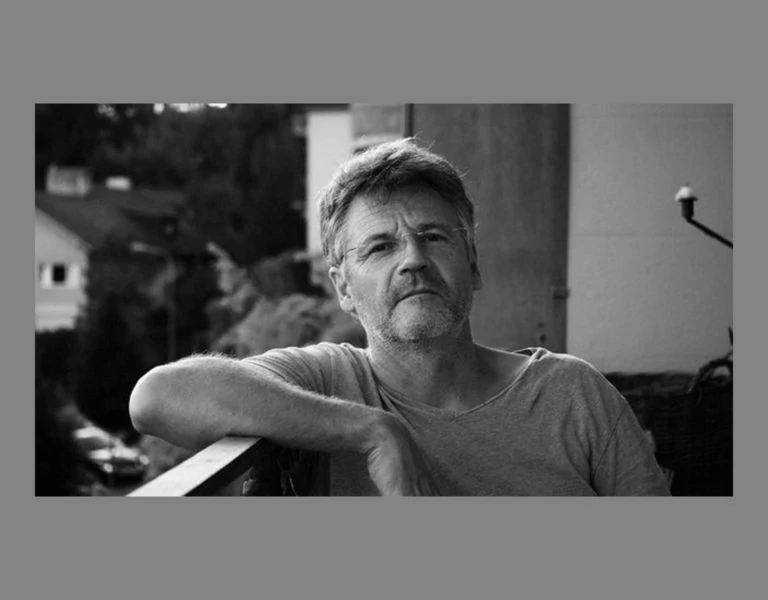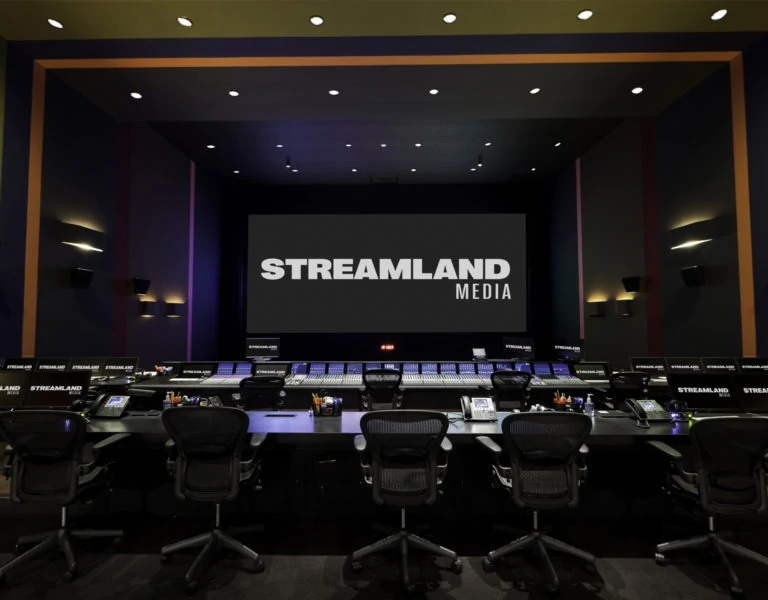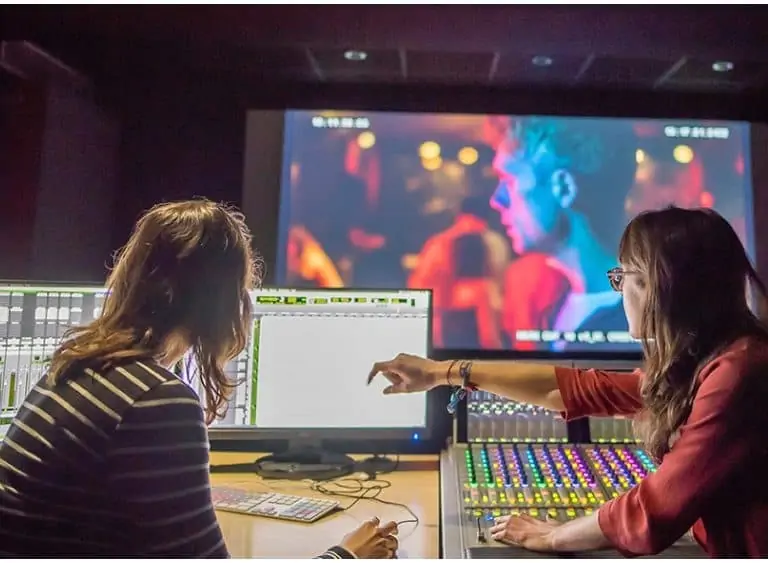Sharp Eyes
Post it Notes / Philippe Ros AFC

Sharp Eyes
Post it Notes / Philippe Ros AFC
The texture of the digital image, through the control of sharpness, is a real artistic issue, says Philippe Ros AFC.
The texture of the digital image is relatively virgin territory, and sharpness plays an important part in it. Choosing the texture and the sharpness are definitively artistic decisions but, in most of the images delivered by the camera, these decisions are essentially created and managed by engineers with talent. But these choices don’t necessarily match the filmic drama, nor the filmmaker’s or cinematographer’s expectations.
Historically, in film, the texture of the image has mostly been tackled during the shoot by lighting, make-up, glass filtering, glued stockings on the back of the lenses, and by the level of grain linked to film stocks, exposure and lab processes. We can easily feel that the film texture is linked to the chaotic pattern of the film grain as opposed to the still, clinical pattern of the digital image. But is it that simple? The digital era offers many opportunities, but presents also several paradoxes and limitations that I will try to outline.
Main concerns – 2K and 4K processes
The issue surrounding texture and sharpness, follow several shoots, and a lot of tests, that I did at 4K with Sony F65 and F55, Canon C500 and 1Dc cameras, as well as several workshops I conducted, including one with cinematographers on 4K and Ultra HD in South Korea. During last year’s Camerimage Festival, I was also involved in a seminar organised by Tiffen with Steven Poster ASC. The debate focussed on how to soften the 4K digital image.
4K is not often used in Europe, but I came to the conclusion that the qualities and the defects we see in 4K are very often the exacerbation of what you start to feel in 2K. And, even if we are not working for a final 4K release, we are increasingly using 4K cameras for a 2K final release. Hence the value of fully-understanding the peculiarities of 4K.
Cinematographers frequently now use Sony F55, RED Epic, Canon C500 and Black Magic cameras at 4K, with the Panasonic Varicam 35 camera next on the block. And during post production we downscale the footage from these cameras to 2K. Whilst all of these cameras deliver 4K resolution, the question is do they offer the same sharpness?
Specifications of 4K cameras
It is difficult to find our bearings in the world of 4K cameras, particularly because of the confusion between photosites and pixels. Pixels appear only during sub-sampling and recording. There are no pixels on the sensor, only photosites. The different sizes of the sensors and the size of photosites adds complexity, and the table below gives a general idea. (Fig 1)
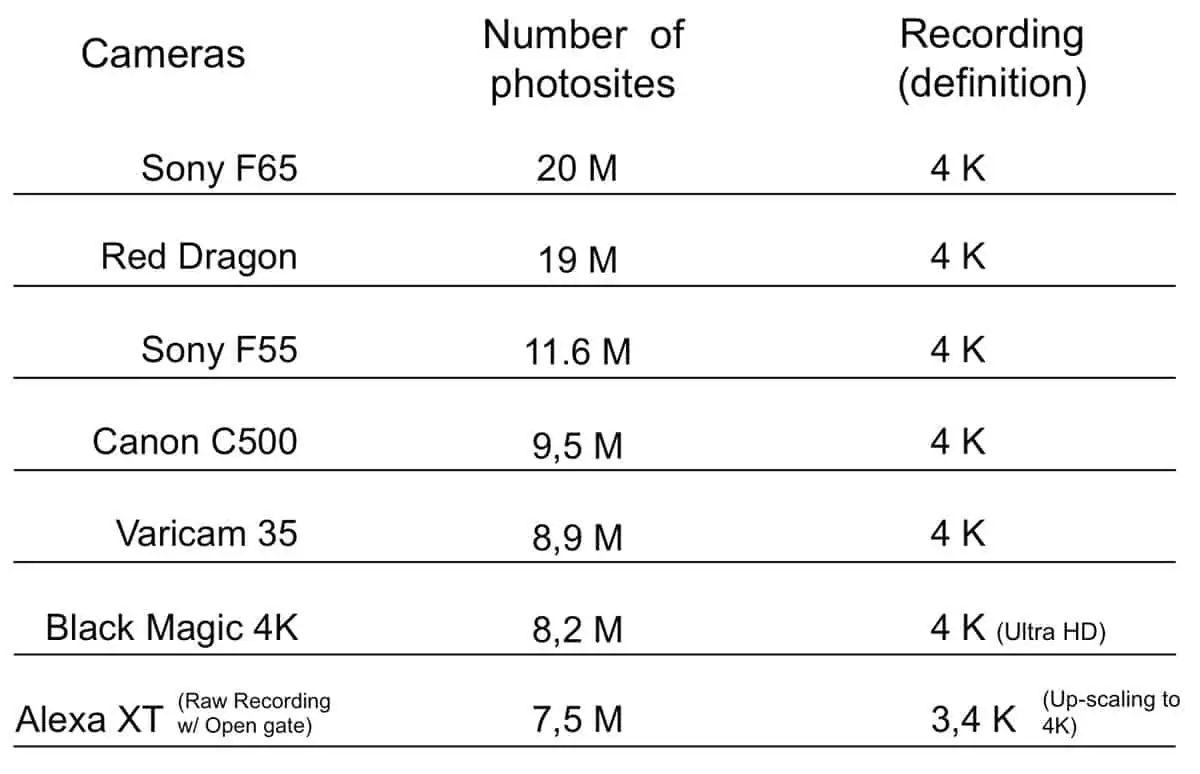
Regarding the sharpness of a 4K image, what is common between one image shot with an F65 or with a RED Epic Dragon, and one shot with a F55 or with a C500? The first two cameras have almost double, or more, photosites than the others. The F65 has 19m photosites on the sensor, whereas the F55 has 9.5m, but they both deliver 4K resolution. Even with the same resolution we realise that we can match large shots made with an F65 with a close shot made with an F55. But the contrary is far less obvious – we cannot readily match close shots made with an F65, to large shots made with the F55.
It’s always possible to up-scale the resolution of a camera in post production. That’s why, in the table, I retained the Alexa, because even before the arrival of the XT and the Open Gate, movies shot with Alexa at a 2.8K resolution have been ‘’blown-up’’ for a 4K digital process, for example Skyfall.
In every camera there are sharpness enhancement tools. Strictly speaking the setting of this function doesn’t belong to the deBayer process, which mathematically generates an RGB file, rather it follows it, and proceeds through various methods including the enhancement of contrast. The control of this setting is becoming more and more within our reach – ARRI was the first to launch this control in the ARRIRAW convertor (ARC). A lot of cameras are using up-scaling processes to reach 4K resolution and the sharpness control to enhance, often artifically, the details. From these two interventions we can feel too much sharpness in some 4K cameras.
Strategies to lower sharpness
A lot of cinematographers appreciate the sharpness of a Sony F55 or a Canon C500 when it comes to wildlife films or advertising for cars. But others, when it comes to a feature film with actors (for TV or cinema release), use glass or digital filtering, and/or older lenses to lower the sharpness. Regarding his work on Mr Turner, Dick Pope BSC said ’’The film looks neither film nor digital," thanks inter alia to a very clever choice of old lenses.
The underlying debate is in fact on the perception of the resolution and of the sharpness – a lot of cinematographers prefer to focus on colour-depth than on the number of pixels. Colour versus resolution, but also colour versus sharpness. It’s a frequent dilemma that we meet in all countries.
But it’s not only the number of pixels which determine the impression of sharpness. A scene shot with an F65 and Leica Summilux-C lenses at T1.4 may appear smooth but sharp, whereas another sequence shot at T2.8 may look too sharp, and require glass or digital filtering.
Choosing to use a 2K down-scaling setting in a 4K camera during a shoot is not so simple. In the RED Epic this setting leads to a zoom-in on the sensor, with the consequence of extending the focal lengths and losing the short ones – a 35mm will become a 45mm. Some cinematographers prefer to keep the 4K resolution of an F55 by using glass filtering or digital filtering.
Changing the OLPF in front of the sensor is an under-developed way for practicable reasons.
It is during camera tests that we get a good opportunity to assess the sharpness. Have a look at the diagram (Fig 2) to remind yourself of the parameters on-set which can govern the feeling of the sharpness.
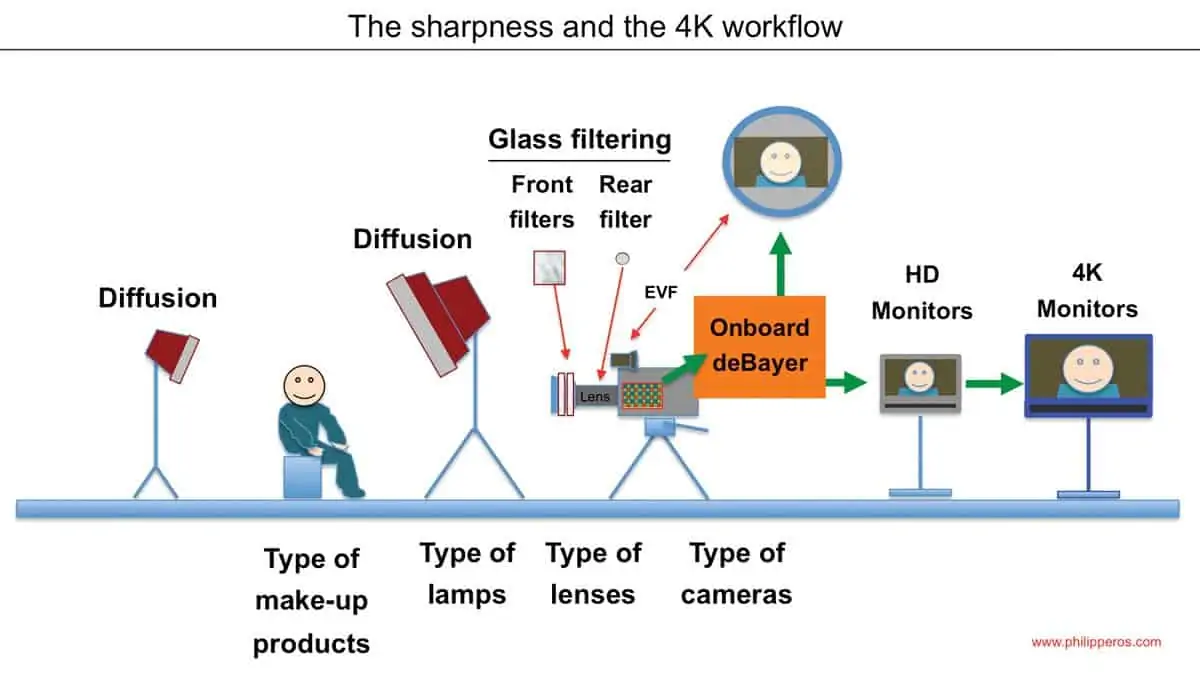
Choosing glass filtering with digital cameras becomes more complex on-set. We must be sure that the onboard deBayer process in the camera is reliable. The WYSIWYG (What You See Is What You Get) specification of the camera is of paramount importance. But with a 4K camera – even for a 2K release – choosing a filter becomes very difficult with an HD monitor, not to mention the electronic viewfinder.
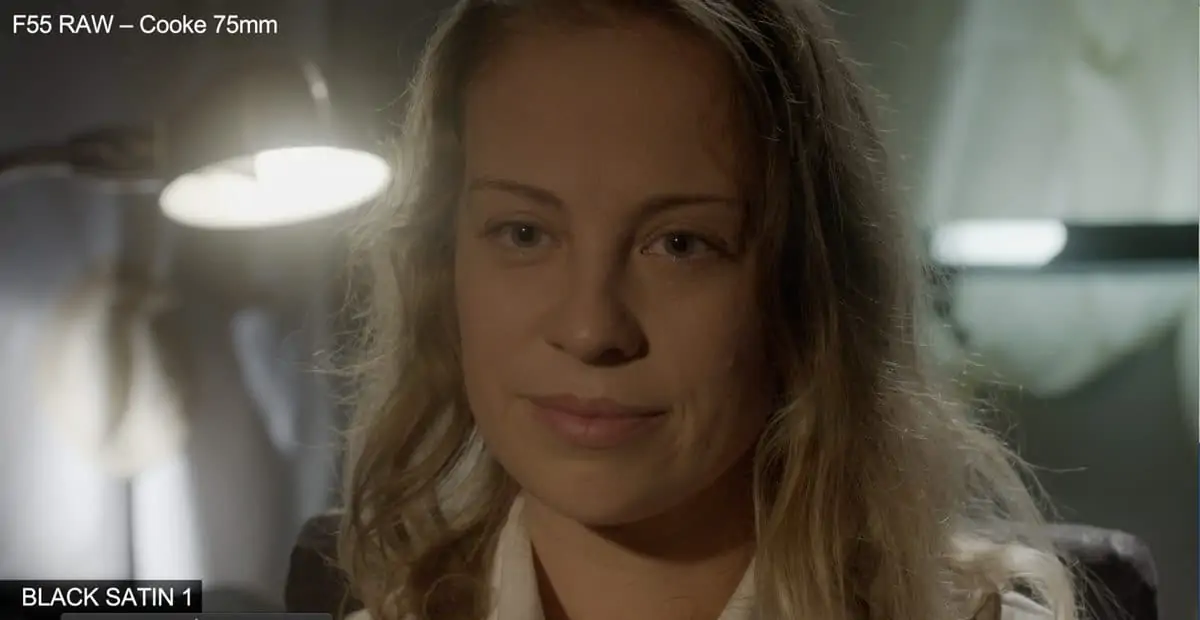
A 4K monitor can be a solution – an expensive one – for a first selection, but the only way to judge the quality remains projection on a large screen. The subtleties of the gradations cannot be distinguished without a simulation of the 4K or 2K workflow.
The diagram (Fig3) indicates the place of the sharpness settings in the workflows using codecs or RAW materials. These workflows give us additional options to set-up the sharpness, as we sometimes have sharpness controls after the deBayer process. In several grading software packages there is a deBayer process, including sharpness adjustment, but they don’t all respect the structure of the image that the camera manufacturer has designed.

ARRI’s policy which certifies the deBayer processes from third party stems (with the ‘Certified For ARRIRAW Processing" label) seems clever and efficient. This empowers a manufacturer, who is assumed to know the camera specifications, to delegate responsibility for other companies without endorsing medium-quality processes.
Through peculiarities of the sensor and the processing of the signal we can distinguish differences of texture between the various camera manufacturers. It is difficult, and very subjective, to quantify the texture, because the whole process depends on the choice of lenses, on the glass and/or the digital filtering, especially on an artistic project.
In the diverse strategies to control sharpness, post production enables the addition of film grain to put back some of the ‘’chaos’’, and specifically allows the use of digital filtering during or after grading.
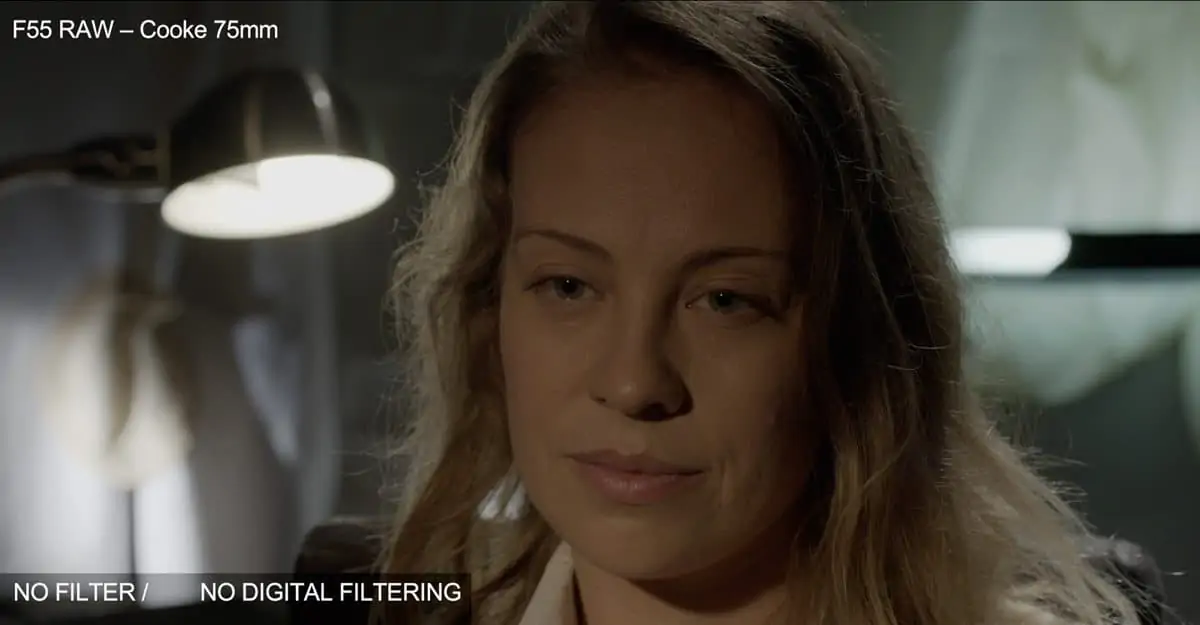
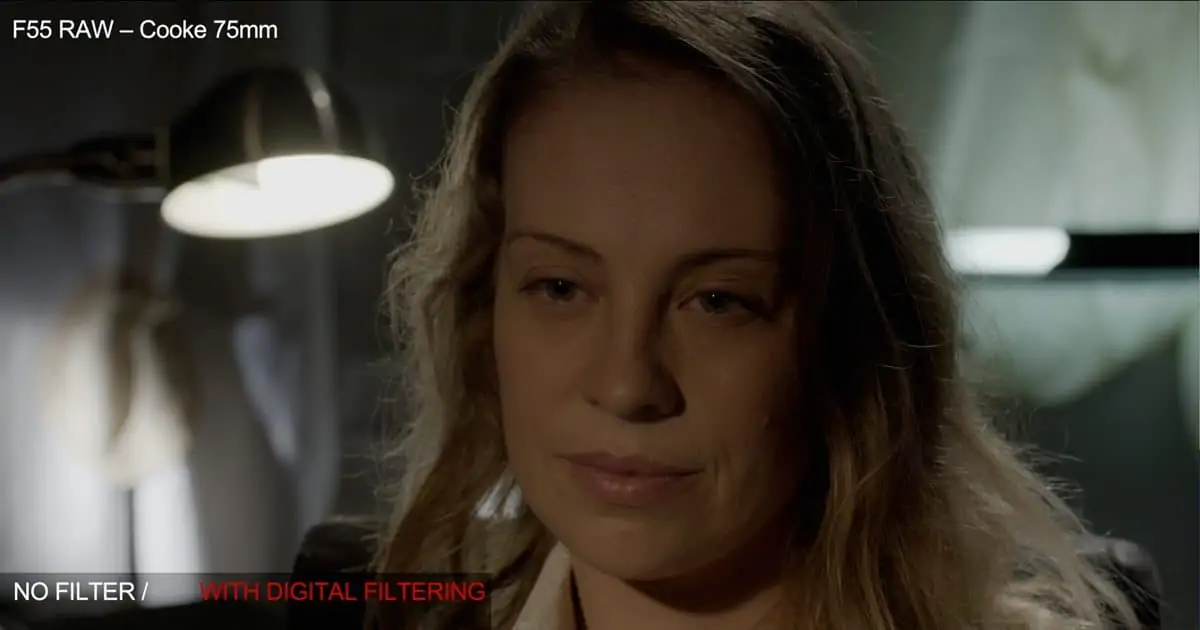
Digital filtering provides the advantage and/or the limitation of not having bias during shooting (which can be hazardous as the working time in the grading suite can grow exponentially). Time and costs of digital filtering remain an obstacle for numerous indie and medium budget movies.
Other strategies
Many cinematographers and colourists regret having to ‘’fight against the machine’’. This brings us quite naturally to this conclusion: before embarking on the mission to mitigate sharpness through glass or digital filtering, it would be wise to emulate the settings of sharpness upstream, similar to the ones provided by the ARC from ARRI, Canon RAW Viewer or RED Rocket during the deBayer process in post, or have the ability to adjust the detail level parameters when codec-recording after the onboard deBayer in the camera. Unfortunately, all of the companies mentioned above offer only one single setting currently.
The diagram (Fig 4) shows the places that we have on the camera and in a workflow to control sharpness.
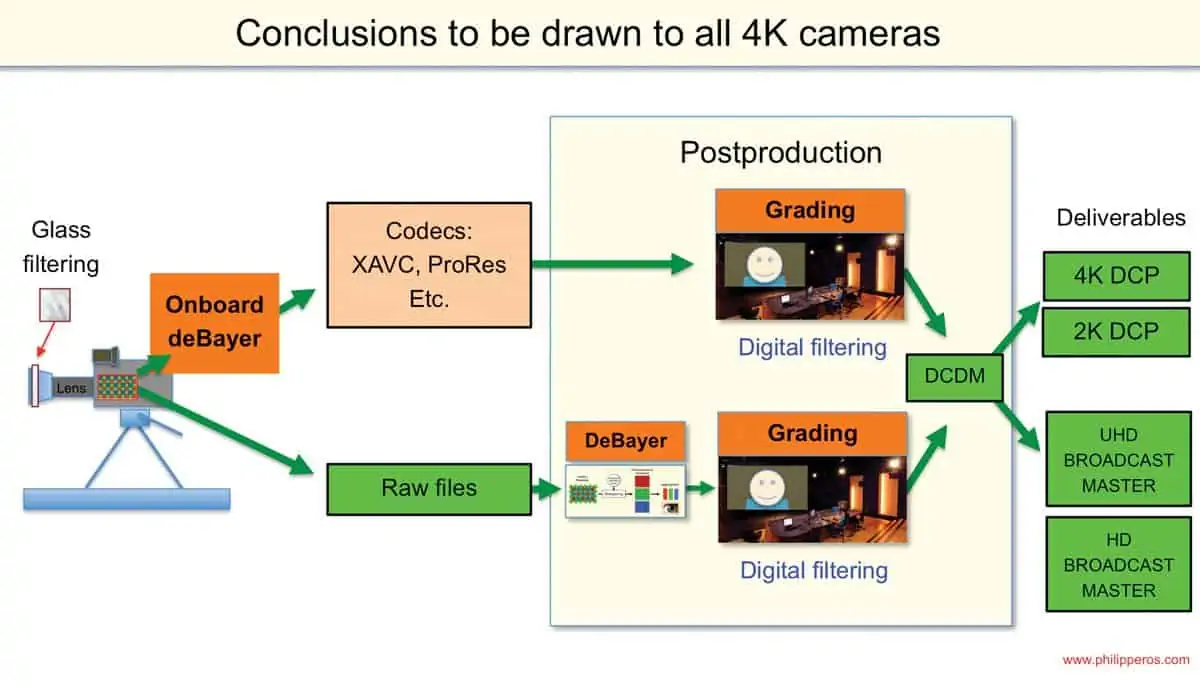
The Sony F55 currently allows us to access these parameters in-camera when recording internal XAVC, even in custom mode with Log curves. For the moment it does not have a large range for adjustments, but it’s an interesting step.
The next agenda of the Technical Committe of IMAGO will develop the request to all camera manufacturers to open and/or to broaden the sharpness controls through different means:
- Allow access to ''Detail Level'' parameters when we are shooting with codecs provided by the onboard deBayer of the camera (e.g. XAVC or ProRes), even when using Log curves.
- Allow access to several parameters of sharpness after deBayer processes in post when shooting RAW.
These parameters already exist on some cameras and software in post, but there is not a broad consensus to provide all the parameters to deal with sharpness. As cinematographer Kommer Kleijn SBC, said, ‘’We have been playing for years with, at minimum, three settings of sharpness after deBayer on Photoshop. But why there is often only a single one to control the sharpness for the movie world?’’.
Conclusion
It seems that we are just starting to tackle the real areas of interest of the digital workflow. Managing texture relies on controlling the sharpness. But there’s not only sharpness in the texture, and Jean-Pierre Beauviala led the way with the moving sensor on the Delta camera. We can add grain in the image, we can tolerate a certain level of noise-to-signal in the image, but we can also regret the chaotic moving structure of the filmstock.
But have we really dug into the possibilities of changing digital texture? I’ve been working for years with colourists, digital artists and camera engineers around the settings of the Detail Levels of HD cameras. We found the way to soften the image and we were encouraged by all the possibilities to change the structure of the image in all parts of the contrast curve, highlights, medium and lowlight areas. Playing with the ‘’coring’’ (which reduces noise by smoothing image pixels) and several other parameters, that I will not bore you with here, helped me to understand that the clinical look we often face is also an ideological point-of-view and most of the time it’s just a setting to be changed. The sharpness settings after the deBayer processes are appearing slowly in several cameras and post softwares.
The texture, the structure, of the pixel are part of an artistic approach to be done obviously upstream of the shoot. We no longer need to attempt to imitate filmstocks. The challenge now is how best to handle the digital image with the real point-of-view being on our perceptions. It’s under-explored territory, and more research and development is to be welcomed.


